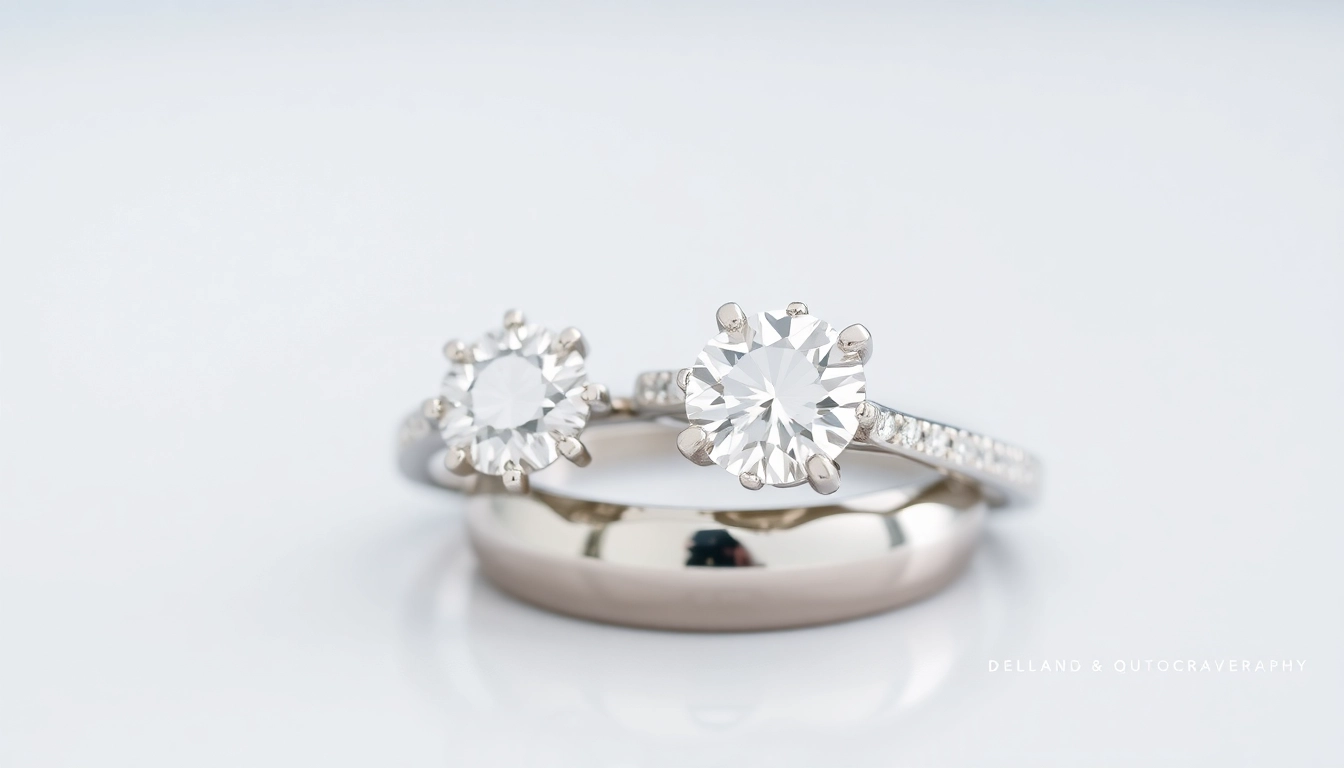Choosing the perfect engagement ring is a milestone that symbolizes love, commitment, and personal style. Among the countless options available, white gold engagement rings have surged in popularity for their elegant appearance, durability, and versatile appeal. This comprehensive guide delves into what makes white gold an exceptional choice for engagement jewelry, how to select the ideal design, maintain its brilliance, stay ahead with emerging trends, and find trustworthy sources to purchase authentic rings that truly shine.
Understanding the Distinctive Features of White Gold Engagement Rings
What Makes White Gold a Popular Choice for Engagement Jewelry
White gold has captured the hearts of many due to its sophisticated, timeless look that closely resembles platinum but at a more accessible price point. Its naturally silvery hue offers a neutral backdrop that complements various gemstone colors, especially diamonds, enhancing their brilliance without overpowering their sparkle. Additionally, white gold is hypoallergenic when alloyed with suitable metals, making it a suitable option for individuals with sensitive skin.
Another contributing factor is adaptability; white gold’s subtle elegance pairs well with both modern and vintage styles, making it versatile across a diverse array of personal tastes. Its durability also rivals or surpasses that of silver and sterling options, providing a resilient choice for everyday wear. For a detailed shopping experience, explore options at trusted jewelers specializing in white gold engagement rings.
Differences Between White Gold and Other Metals Like Platinum or Silver
While white gold, platinum, and silver often look similar at a glance, understanding their fundamental differences is essential for making an informed decision. White gold is an alloy comprising gold and other metals such as palladium, nickel, or manganese, which gives it strength and a silvery appearance. In contrast, platinum is a naturally white, dense, and highly durable metal, often more hypoallergenic but more expensive.
Silver, on the other hand, is softer, more affordable, but prone to tarnishing and scratches. Its lower durability means it may require more frequent maintenance. White gold strikes a balance by offering the aesthetic appeal of platinum with better affordability and durability suitable for daily use, although it requires periodic rhodium plating to maintain its brightness.
Types of White Gold Alloys and Their Impact on Durability
The strength and appearance of white gold depend heavily on its alloy composition. Common alloy combinations include 14k, 18k, and even 10k purity levels. Higher karatages such as 18k contain a greater proportion of pure gold, resulting in a richer color but slightly softer surface properties. Conversely, 14k white gold is more robust and scratch-resistant, making it ideal for engagement rings that will endure daily wear.
Various alloying metals influence properties: palladium offers a natural white hue and corrosion resistance, nickel provides strength but may cause allergies, while manganese and zinc can enhance alloy stability. When selecting a white gold ring, consider your lifestyle and sensitivity—opting for a higher-grade alloy for longevity and peace of mind.
How to Select the Perfect White Gold Engagement Ring
Key Factors to Consider: Style, Metal Purity, and Budget
Choosing an engagement ring calls for a balance between aesthetic preference, material qualities, and financial considerations. Style-wise, classic solitaire settings showcase the diamond’s brilliance, while halo, pave, or vintage-inspired designs offer a distinctive flair. Metal purity influences both the appearance and durability; higher purity (like 18k) provides a richer gold tone but may be softer, whereas lower purity (14k) offers increased resilience.
Budget constraints shape the overall design options. White gold allows for a luxurious look without the high cost associated with platinum. It’s essential to determine your priorities—whether you want maximum durability, the purest color, or a specific design—and choose accordingly. Consulting with reputable jewelers can clarify selections and help you find pieces that match your vision and financial plan.
Popular Designs and Customization Options in White Gold Rings
The modern bride’s preference ranges from minimalist bands with solitary stones to elaborate settings embedded with multiple diamonds or colored gemstones. Popular settings include prong, bezel, and tension styles, each offering different visual effects and security levels. Customization options allow couples to add personal touches—engraving messages, selecting unique gemstone cuts, or incorporating mixed metals—to craft a truly bespoke piece.
Many jewelers now offer bespoke design services, enabling you to collaborate with artisans to create a one-of-a-kind ring that mirrors your love story and style preferences. Tailoring your ring ensures it stands out and resonates with personal meaning, making it more than just a piece of jewelry.
Tips for Matching White Gold Engagement Rings with Wedding Bands
Achieving harmony between your engagement ring and wedding band enhances overall elegance. For a seamless look, many opt for matching metals and similar design elements. If your engagement ring features intricate detailing, choosing a complementary band with subtle embellishments can create a balanced aesthetic. Alternatively, stacking different textures or widths can add visual interest.
Consider factors like comfort and daily practicality—smooth profiles and secure fit are essential. When in doubt, consult with your jeweler for expert advice on pairing styles that complement each other, ensuring lasting beauty and comfort.
Maintaining the Beauty of Your White Gold Engagement Ring
Cleaning and Care Tips for Long-Lasting Shine
White gold jewelry requires proper care to preserve its luster. Regular cleaning with a mixture of mild soap and warm water, along with a soft cloth or brush, prevents buildup of oils and dirt that dull the metal. For a deeper clean, ultrasonic cleaners designed for jewelry can be used but should be avoided if the ring contains glued-in stones or fragile settings.
Rhodium plating, commonly applied to white gold, can fade over time, diminishing the ring’s brightness. Reapplication by a professional jeweler is recommended every 1–2 years to restore its original shine.
Professional Maintenance and When to Seek Repairs
Periodic inspections by a professional jeweler help catch issues like loose settings, scratches, or signs of wear early. Skilled repairs—such as re-shanking or re-engraving—extend the lifespan of your ring. If you notice any damage or if the ring no longer fits properly, seek prompt professional assistance to prevent further deterioration.
Common Wear and Tear: Prevention and Solutions
Daily activities can lead to scratches, dents, or tarnishing. To prevent damage, remove your ring during heavy manual work, cleaning, or exposure to harsh chemicals. Storing your jewelry separately in soft pouches or compartments reduces surface abrasions. Applying a protective coat of jewelry wax or sealant can also provide an additional layer of defense. Regular professional polishing keeps your ring looking pristine for years.
Latest Trends and Innovations in White Gold Engagement Rings
Current Popular Styles and Setting Types
Modern trends favor unique settings such as Halo, trillion, and asymmetrical designs, often combined with intricate metalwork. Bold, solitaire styles with large center stones remain timeless staples. Filigree and milgrain detailing add vintage charm, while sleek, minimalist bands cater to contemporary tastes.
Emerging Design Trends and Unique Custom Pieces
Designers innovate with mixed-metal accents, sustainable gemstones, and custom engraving techniques. Eco-conscious consumers seek ethically sourced white gold and conflict-free diamonds, integrating transparency into their purchase. Customized geometric shapes or nature-inspired motifs personalize each ring, making it a meaningful expression of love.
Choosing Ethically Sourced and Eco-Friendly White Gold Rings
Sustainability considerations are increasingly influencing purchase decisions. Look for jewelers certifying ethically mined gold and conflict-free diamonds. Some brands incorporate recycled metals and traceable sourcing to reduce environmental impact. Choosing eco-friendly white gold not only benefits the planet but also aligns with the values of socially conscious consumers.
Where to Buy Authentic White Gold Engagement Rings
Trusted Retailers and Certified Jewelers
Your best bet for authentic, high-quality white gold engagement rings is a reputable jeweler with certification from trusted gemological institutes such as GIA or IGI. Established brands and local jewelers with proven track records offer warranties, after-sales support, and detailed appraisals to ensure authenticity and value.
Online vs. In-Store Purchase Pros and Cons
Online shopping provides convenience, a broader selection, and often better prices. However, it requires thorough research, clear return policies, and trustworthiness. In-store purchases allow tactile examination, personalized consultations, and immediate customizations, ideal for buyers who prefer face-to-face service. Combining both approaches—researching online then visiting a physical store—can optimize your buying experience.
Ensuring Fair Pricing and Authenticity Guarantee
Always request certification for diamonds and precious metals. Comparing prices across reputable sources helps identify fair market value. Beware of deals that seem too good to be true; verify the seller’s reputation through reviews and licensing. A transparent jeweler will provide detailed documentation, including metal purity reports and gemstone certificates, ensuring your investment’s authenticity.

